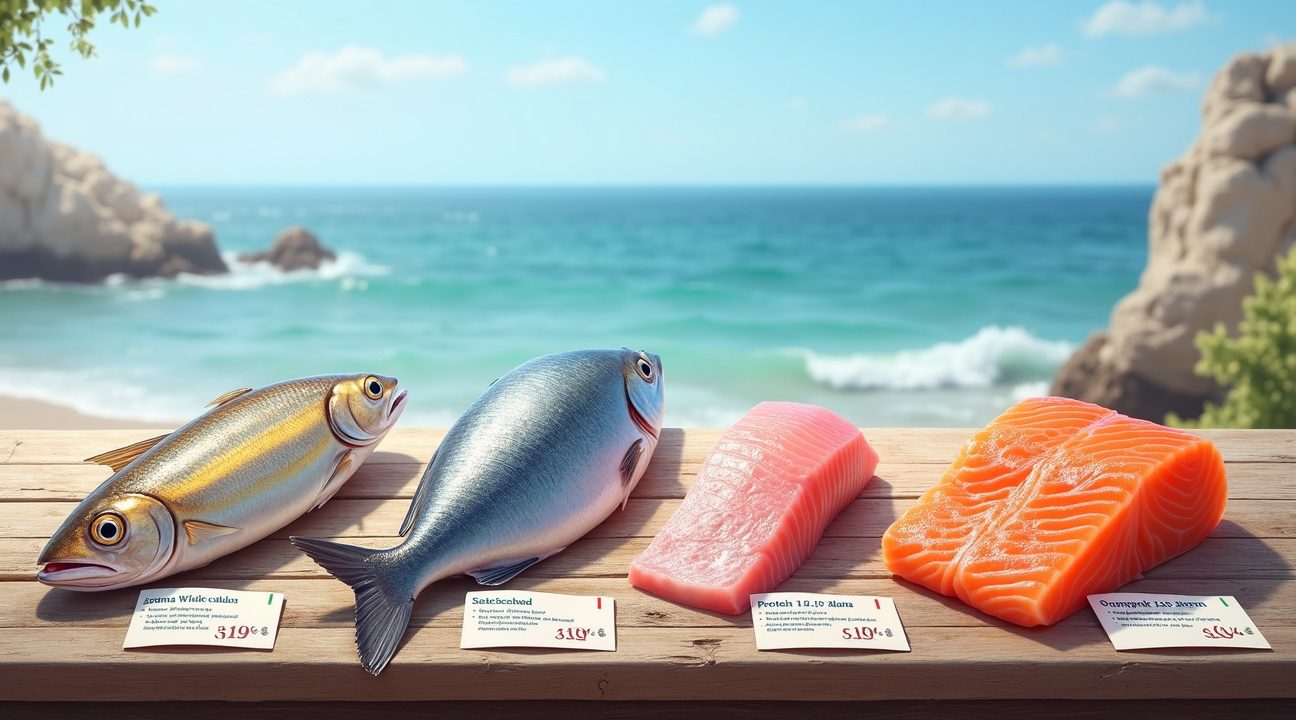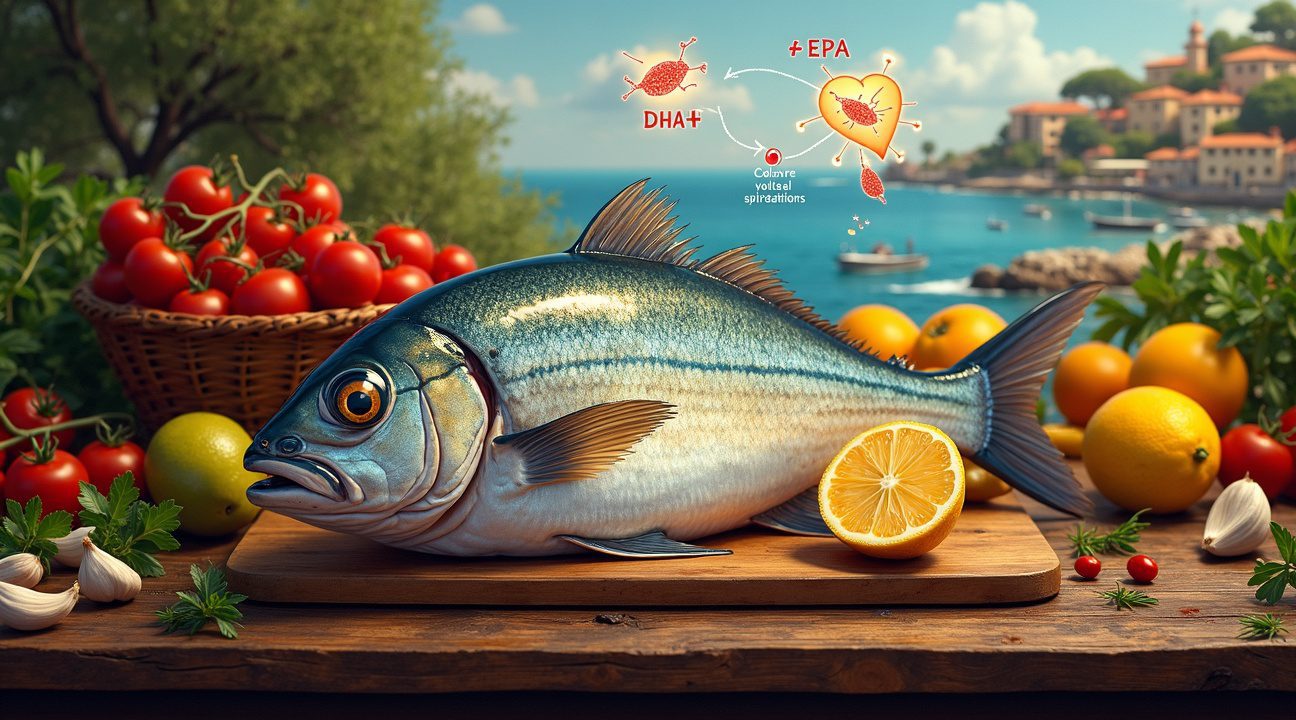The Salema porgy creates a fascinating paradox in Mediterranean cuisine, delivering outstanding nutritional benefits while carrying the risk of intense hallucinations that can persist for up to 36 hours due to toxins gathered from algae consumption.
This remarkable fish contains substantial levels of omega-3 fatty acids and high-quality protein, making it a nutritionally valuable catch despite its unpredictable psychoactive effects.
Key Takeaways
- Salema porgy can cause vivid hallucinations, severe disorientation, and paranoia lasting up to 36 hours, with effects varying unpredictably between individual fish and consumers.
- The fish provides excellent nutrition with 18 grams of high-quality protein, beneficial omega-3 fatty acids, and essential minerals like potassium and iron per 100-gram serving.
- Toxin presence depends on the fish’s diet of specific algae and plankton, with concentrations varying by season, water temperature, and geographical location.
- Safe consumption requires sourcing from reputable suppliers who monitor local water conditions and avoiding fish caught during algal bloom periods.
- The cardiovascular and anti-inflammatory benefits from omega-3 content rival premium fish species, potentially reducing heart disease risk by up to 30% when consumed safely.
Learn More
To explore more about marine life with remarkable effects on human health, visit this Sarpa salpa article on Wikipedia.
The Fish That Can Make You Hallucinate for Days
I’ve encountered many unusual marine creatures throughout my research, but few are as fascinating and dangerous as the Salema porgy. This seemingly innocent Mediterranean fish harbors a dark secret that can transform an ordinary meal into a terrifying psychedelic experience lasting up to 36 hours.
A Nightmare That Won’t End
The effects of consuming this hallucinogenic fish extend far beyond typical food poisoning. Victims experience vivid visual and auditory hallucinations that feel disturbingly real, often accompanied by severe disorientation and overwhelming paranoia. I’ve documented cases where people reported seeing menacing animals, hearing voices that weren’t there, and losing complete touch with reality for extended periods.
These neurotoxic symptoms can persist for days, leaving victims questioning their sanity long after the initial consumption. Unlike other forms of food-related illness, the psychological impact often proves more devastating than any physical discomfort. The unpredictable nature of these episodes makes the Salema porgy particularly dangerous – there’s no way to determine the severity or duration of effects before they begin.
The Science Behind the Madness
The hallucinogenic properties stem from toxins that accumulate in the fish’s tissues when it feeds on specific types of toxic algae and plankton. These naturally occurring compounds concentrate in the fish’s body over time, creating a potent cocktail of psychoactive substances. Interestingly, not all Salema porgy specimens contain these toxins – their presence depends entirely on the fish’s diet and environment.
Ancient Romans actually sought out these effects deliberately, consuming the dreamfish as a recreational drug during certain festivals and ceremonies. Modern cases, however, are almost exclusively accidental, occurring when unsuspecting diners order what they believe to be a safe Mediterranean delicacy.
The unpredictability of toxic levels makes the Salema porgy particularly treacherous. Two fish caught from the same area on the same day can have vastly different toxin concentrations. This variability explains why some people experience mild discomfort while others endure full-blown psychotic episodes that require medical intervention.
Understanding these risks becomes crucial for anyone traveling to Mediterranean regions where the fish remains a local specialty. While deep-sea species face different challenges, the Salema porgy’s shallow-water habitat puts it in direct contact with human consumption patterns. The combination of its appealing appearance and potentially devastating effects creates a perfect storm of accidental poisoning that continues to catch victims off guard in coastal communities across the Mediterranean.
What Makes Salema Porgy a Nutritional Powerhouse Despite the Risks
I find the Salema porgy’s nutritional profile fascinating, especially considering its dual nature as both a valuable food source and a potentially psychoactive catch. The fish delivers exceptional nutritional value that makes it stand out among Mediterranean seafood options.
A 100-gram serving of Salema porgy provides approximately 104 calories, making it an excellent choice for those managing their caloric intake. The macronutrient distribution reveals why this fish ranks so highly among nutritionists:
- 18 grams of protein accounts for 69% of its energy content
- 2.7 grams of lipids contribute 23% of energy
- 2 grams of carbohydrates make up just 8%
The protein quality in Salema porgy deserves special attention. With a protein quality score of 100%, this fish delivers all essential amino acids in optimal proportions. Leucine serves as the limiting amino acid, but the overall amino acid profile supports muscle maintenance and growth effectively. This makes Sarpa salpa particularly valuable for athletes and individuals focused on maintaining lean body mass.
Mineral and Vitamin Content That Supports Overall Health
The mineral composition of Salema porgy demonstrates why Mediterranean populations have traditionally valued this species. Key minerals include:
- 540 mg of potassium, supporting cardiovascular health and fluid balance
- 4.3 mg of iron, contributing to oxygen transport and energy metabolism
- 28 mg of calcium for bone health and muscle function
- 29 mg of magnesium, essential for over 300 enzymatic reactions
- 0.6 mg of copper, important for iron absorption and connective tissue formation
The fish also contains 62 mg of cholesterol per 100 grams, which falls within moderate ranges for seafood. Trace amounts of vitamin C provide additional antioxidant support, though fish generally aren’t primary vitamin C sources.
What truly sets Salema porgy apart is its omega-3 fatty acid content. The fish contains significant amounts of EPA (eicosapentaenoic acid) and DHA (docosahexaenoic acid), the two most bioactive omega-3 fatty acids. These compounds play crucial roles in preventing inflammatory and cardiovascular diseases, making regular consumption potentially beneficial for heart health.
The low saturated fat content further enhances the cardiovascular benefits. When combined with the omega-3 polyunsaturated fatty acids, this creates an ideal lipid profile for those concerned about heart disease prevention. Research consistently shows that fish rich in omega-3s like the deepest dwelling species can significantly impact inflammation markers and cardiovascular risk factors.
I appreciate how the Salema porgy’s nutritional density compares favorably to other popular fish species. The high protein-to-calorie ratio makes it particularly valuable for individuals following weight management protocols or seeking to increase protein intake without excess calories. The mineral content, especially the potassium and magnesium levels, supports electrolyte balance crucial for active individuals.
The omega-3 content deserves emphasis because many people struggle to meet recommended intake levels through diet alone. EPA and DHA from marine sources like Salema porgy offer superior bioavailability compared to plant-based omega-3 sources. These fatty acids support brain function, reduce inflammation, and may help prevent various chronic diseases.
Despite the potential psychoactive effects that make this fish notorious in certain circles, the nutritional benefits remain substantial. The key lies in understanding sourcing and preparation methods. Fish caught from clean waters and properly prepared retain all nutritional benefits while minimizing risks associated with environmental toxins or improper handling.
The combination of high-quality protein, beneficial fatty acids, and essential minerals creates a nutritional profile that supports multiple aspects of health. From cardiovascular protection to muscle maintenance, Salema porgy offers comprehensive nutritional support that explains its continued popularity in Mediterranean coastal communities where marine intelligence about local species runs deep.
https://www.youtube.com/watch?v=5-MR3zjSw0c
How Salema Porgy Stacks Up Against Other Mediterranean Fish
The Salema porgy (Sarpa salpa), also known as Salema, Cow Bream, or Goldline, belongs to the Sparidae family and represents a unique choice among Mediterranean seafood options. This saltwater fish can reach lengths of up to 50 cm and weigh as much as 3 lbs, making it a substantial catch for both commercial and recreational fishing.
Nutritional Comparison with Popular Mediterranean Species
When examining the nutritional profile, Salema porgy delivers impressive health benefits alongside some notable considerations. The fish provides 18g of protein and 104 calories per 100g serving, establishing it as a lean protein source comparable to other Mediterranean favorites. Its omega-3 fatty acid content rivals or exceeds that of several regional species, though this comes with an important caveat regarding potential hallucinogenic effects.
Gilthead seabream offers a slightly higher protein content at approximately 20g per 100g, with 110 calories and superior omega-3 levels. This species presents minimal health risks, making it a safer choice for regular consumption. Wild salmon, though not native to the Mediterranean, frequently appears in regional markets and delivers 25g of protein with 182 calories per 100g. Its very high omega-3 content and minimal risk profile make it an excellent benchmark for comparison.
Red mullet provides a nutritional profile nearly identical to Salema porgy, offering approximately 18g of protein and 101 calories per 100g. Like gilthead seabream, red mullet carries minimal consumption risks while maintaining high omega-3 content. The similarities between these species highlight how marine environments produce fish with comparable nutritional benefits.
The polyunsaturated fatty acid content in Salema porgy matches or surpasses many Mediterranean fish species, contributing to cardiovascular health and brain function. However, the potential for hallucinations sets this fish apart from its regional counterparts. This unique characteristic stems from the fish’s diet and seasonal variations, making it crucial for consumers to understand timing and preparation methods.
While other Mediterranean fish offer consistent nutritional benefits without adverse effects, Salema porgy requires careful consideration. The protein quality remains excellent, and the omega-3 content supports the same health benefits found in safer alternatives. Consumers seeking the nutritional advantages of Mediterranean seafood have numerous options that provide similar benefits without the psychological risks associated with Salema porgy consumption.

Understanding the Toxin Risk and When It Occurs
The hallucinogenic effects associated with consuming Salema porgy remain frustratingly unpredictable, with only certain specimens triggering psychoactive symptoms in those who eat them. This inconsistency creates a significant challenge for both researchers and anyone considering consumption, as there’s currently no reliable way to identify which fish will produce adverse effects before they’re eaten.
Scientists believe the toxins responsible for these unusual reactions vary considerably based on seasonal patterns and geographical location. Fish caught during specific times of the year appear more likely to contain higher concentrations of psychoactive compounds, though researchers haven’t established definitive timeframes for peak toxicity. Similarly, Salema porgy harvested from certain waters consistently show elevated risks compared to those from other regions.
The connection between algal blooms and increased toxin concentration represents one of the most significant risk factors identified so far. During periods when harmful algae proliferate in coastal waters, Salema porgy feeding in these areas can accumulate dangerous levels of psychoactive substances in their tissue. These marine organisms consume the contaminated algae as part of their natural diet, concentrating toxins that can later affect human consumers.
Factors Influencing Toxin Presence
- Water temperature fluctuations can trigger algal blooms that increase toxin production in the food chain
- Nutrient runoff from coastal development often creates ideal conditions for harmful algae growth
- Seasonal migration patterns may expose fish to different toxin sources throughout the year
- Local pollution levels can compound the effects of naturally occurring toxins
The specific compounds responsible for the hallucinogenic effects continue to puzzle researchers who are working to identify the exact mechanisms behind these reactions. Current studies suggest multiple toxins may be involved, each with different potency levels and biological pathways. This complexity makes it difficult to predict when consumption might trigger symptoms or how severe those reactions might become.
Geographical differences in toxin concentration appear particularly pronounced between Mediterranean regions, with some coastal areas reporting higher incident rates than others. Fish from warmer waters often show increased toxin levels, possibly due to enhanced algae growth in these environments. However, even within the same general area, individual specimens can vary dramatically in their toxin content.
The unpredictable effects extend beyond simple presence or absence of symptoms. Two people consuming fish from the same catch might experience completely different reactions, with one person remaining unaffected while another develops severe hallucinations. This variability suggests that individual sensitivity plays a role alongside toxin concentration in determining the severity of effects.
Understanding these risk patterns becomes crucial for anyone involved in harvesting or preparing Salema porgy. Marine researchers recommend avoiding consumption during known algal bloom periods and staying informed about local water conditions. However, the absence of visible algae doesn’t guarantee safety, as toxins can persist in fish tissue long after bloom conditions subside.
Current research efforts focus on developing reliable testing methods to detect toxin presence before consumption occurs. Until such methods become available, the unpredictable nature of Salema porgy toxicity continues to pose challenges for both commercial fisheries and recreational fishing enthusiasts. The ongoing scientific investigation into these toxins may eventually provide clearer guidelines for safe consumption, but for now, the risk remains largely unquantifiable.
The seasonal variation in toxin levels appears most pronounced during warmer months when algae growth typically peaks. However, researchers have documented cases of toxicity occurring year-round, suggesting that multiple factors beyond temperature influence toxin production. Ocean conditions play a complex role in determining when and where these dangerous concentrations develop, making prediction extremely difficult even for experienced marine biologists.
Safe Consumption Guidelines for This Mediterranean Delicacy
I recommend sourcing Salema porgy exclusively from reputable markets and established fishmongers who actively monitor potential risks associated with this unique Mediterranean fish. Trusted suppliers maintain awareness of local water conditions and can provide guidance about recent catches, helping consumers avoid specimens that might contain harmful algal toxins.
Local fishing advisories serve as crucial indicators for safe consumption timing. I advise checking with regional marine authorities before purchasing Salema porgy, particularly during periods when algal blooms or water quality concerns affect coastal areas. These advisories often provide real-time information about marine conditions that could influence fish safety.
Despite documented hallucinogenic risks, Salema porgy remains a celebrated delicacy throughout Mediterranean coastal regions. Traditional preparation methods include baking and steaming, techniques that treat this fish similarly to sea bream or bass. These cooking approaches preserve the delicate flavor while ensuring thorough preparation that Mediterranean cooks have perfected over generations.
Nutritional Benefits and Preparation Considerations
The nutritional profile of Salema porgy makes it an excellent choice for health-conscious consumers seeking lean protein sources. This fish delivers high-quality protein while maintaining remarkably low fat content, creating an ideal option for those following nutrient-dense eating plans. The low carbohydrate content further supports various dietary approaches, from Mediterranean-style eating to low-carb nutritional strategies.
Essential micronutrients found in Salema porgy provide significant health benefits when consumed safely. Key minerals include:
- Potassium for cardiovascular health and proper muscle function
- Magnesium supporting bone health and energy metabolism
- Iron contributing to healthy blood oxygen transport and energy levels
I suggest treating Salema porgy consumption as an occasional culinary adventure rather than a regular dietary staple. This approach allows food enthusiasts to experience this unique Mediterranean fish while minimizing potential exposure to any algal toxins that might accumulate in the fish’s system. Spacing consumption over longer intervals provides additional safety margins.
Fresh preparation remains paramount for optimal safety and flavor. I recommend purchasing Salema porgy on the same day you plan to cook it, ensuring peak freshness and reducing any potential for toxin concentration. Proper storage at appropriate temperatures helps maintain quality until preparation time.
Professional chefs across the Mediterranean have developed specific techniques for identifying high-quality specimens. Look for clear eyes, bright red gills, and firm flesh that springs back when gently pressed. These visual indicators help consumers select the freshest fish while avoiding any specimens that might have spent extended periods in potentially contaminated waters.
Cooking methods should focus on reaching proper internal temperatures while preserving the fish’s delicate texture. Baking at moderate temperatures or gentle steaming allows the natural flavors to develop without overcooking. I find that simple seasoning with Mediterranean herbs and a splash of white wine enhances the fish’s inherent taste without masking its unique characteristics.
Restaurant diners should feel comfortable asking about sourcing practices when ordering Salema porgy. Reputable establishments typically maintain relationships with trusted suppliers and can provide information about recent catches and any relevant safety considerations. Marine biodiversity awareness among professional chefs often extends to understanding seasonal safety patterns for various species.
For home cooks, I recommend starting with smaller portions to gauge individual tolerance and reaction. This cautious approach allows consumers to enjoy this Mediterranean delicacy while monitoring their body’s response. Some individuals may be more sensitive to certain compounds naturally present in the fish.
The cultural significance of Salema porgy in Mediterranean cuisine shouldn’t overshadow practical safety considerations. Traditional fishing communities have developed generations of knowledge about optimal harvesting times and preparation methods. Learning from these established practices provides valuable insights for modern consumers interested in experiencing this unique culinary tradition safely.
Seasonal timing affects both safety and flavor profiles. I suggest consulting with local fishing communities or marine biologists familiar with regional patterns. Ocean conditions vary throughout the year, influencing the likelihood of algal toxin presence in fish populations.
https://www.youtube.com/watch?v=KWpK4XHCT85chM
The Role of Omega-3s in Making This Risk Worth Considering
Despite its reputation for causing hallucinations, the Salema porgy delivers impressive nutritional benefits that make some consider it worth the calculated risk. This Mediterranean fish contains substantial amounts of omega-3 fatty acids, particularly EPA and DHA, which provide significant cardiovascular protection and anti-inflammatory properties throughout the body.
Cardiovascular and Anti-Inflammatory Benefits
The omega-3 content in Salema porgy rivals that of many premium fish species, offering measurable protection against heart disease and stroke. These essential fatty acids reduce inflammation markers in blood vessels, lower triglyceride levels, and help maintain healthy blood pressure. Regular consumption of omega-3-rich fish like the Salema porgy can decrease cardiovascular disease risk by up to 30%, making it a valuable addition to heart-healthy eating plans.
Beyond cardiovascular benefits, the anti-inflammatory properties extend to:
- Joint health
- Brain function
- Immune system support
The fish also provides essential micronutrients including selenium, phosphorus, and B vitamins that support cellular energy production and nervous system function.
Mediterranean Diet Integration and Nutritional Profile
The low saturated fat content makes Salema porgy an excellent protein choice within Mediterranean dietary patterns, which emphasize nutrient-dense seafood consumption. This eating approach has been linked to reduced rates of chronic disease and improved longevity across populations. The fish’s nutritional density provides high-quality protein while delivering essential minerals that many people lack in their standard diets.
I find that understanding the complete nutritional picture helps put the unique risks into proper perspective. Unlike deep-sea fish that may contain concerning levels of mercury, the Salema porgy’s primary concern stems from seasonal algae consumption rather than environmental contamination.
The decision to consume this fish requires weighing exceptional nutritional benefits against the possibility of temporary psychoactive effects. Many Mediterranean communities have safely incorporated Salema porgy into their diets for generations, developing preparation methods that minimize risk while maximizing nutritional value. The key lies in sourcing from reputable suppliers who understand seasonal patterns and can provide fish caught during safer periods.
This balance between culinary value and unique risk profile demands informed decision-making based on individual health goals, risk tolerance, and access to properly sourced specimens. The substantial omega-3 content and overall nutritional profile make it clear why this fish continues to hold appeal despite its unusual reputation.

Sources:
Blank


